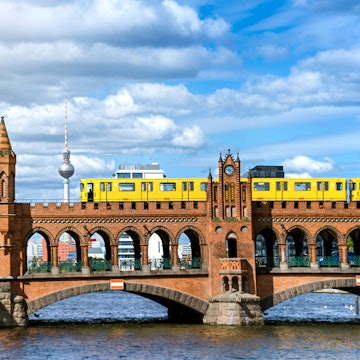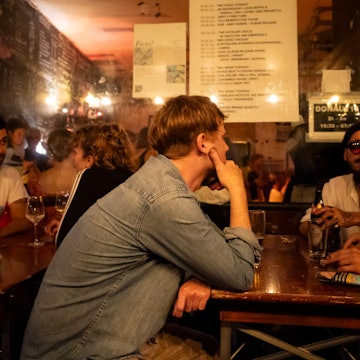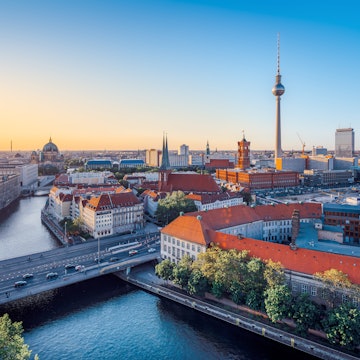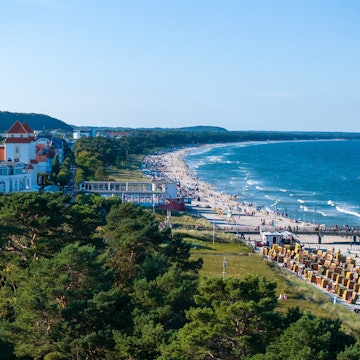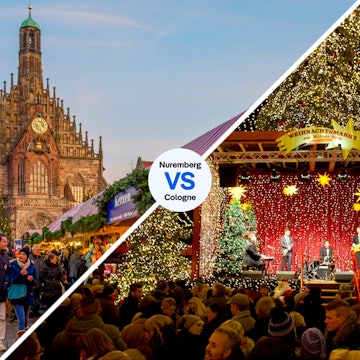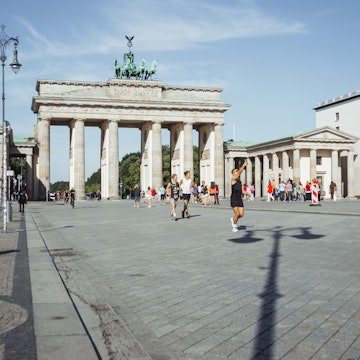
16 must-try foods and drinks in Germany – and the best places to enjoy them

Dec 17, 2024 • 15 min read
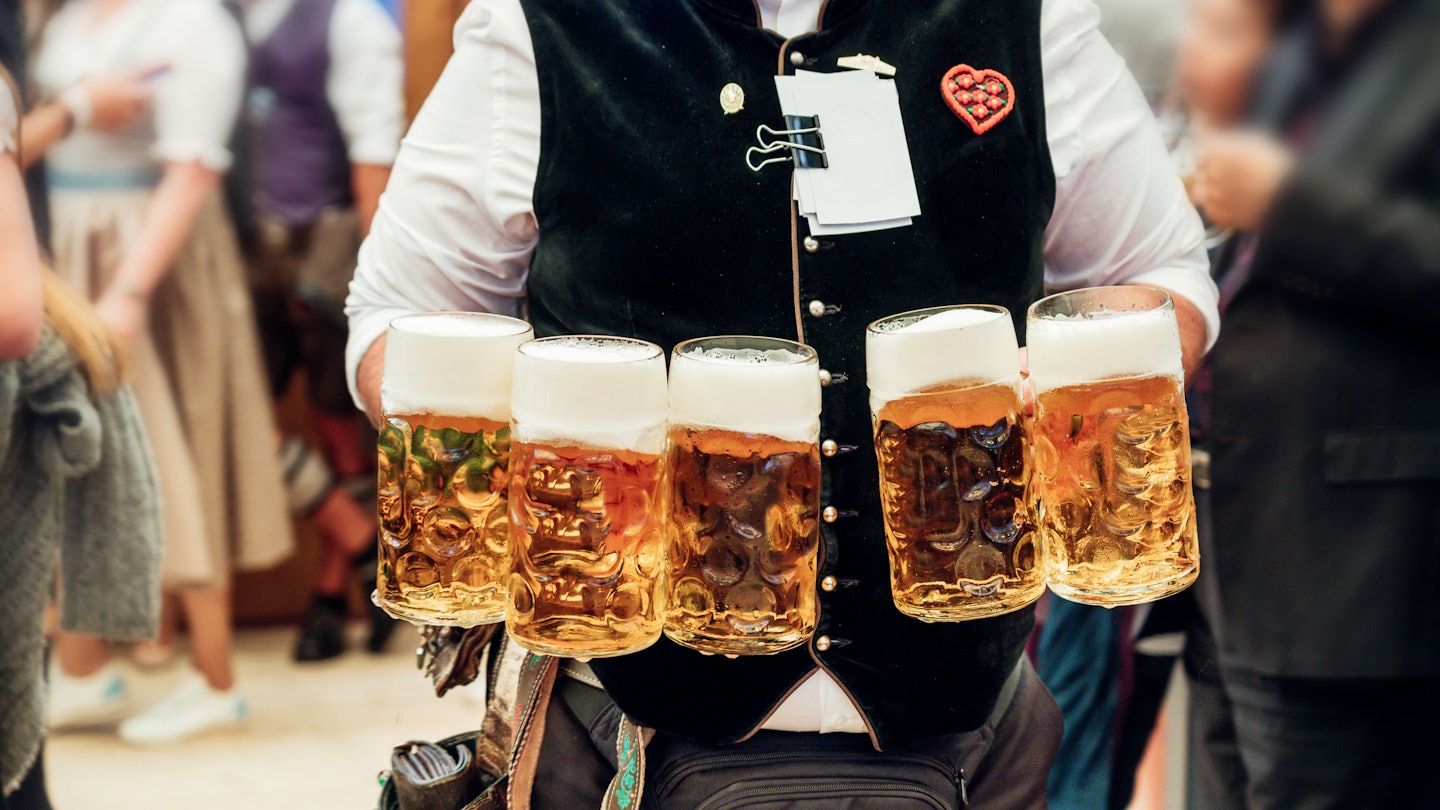
From Currywurst and Döner in Berlin to beer and pork in Bavaria, here are the best things to eat and drink in Germany © Nikada / Getty Images
Sausages with sauerkraut. Dumplings as big as snowballs. Schnitzels the size of boots. Pretzels bigger than your head. And foaming tankards of Bier – glorious Bier!
German food brings a blizzard of clichés. Some are warranted, some not. Yes, this country does still have a taste for piggy parts, potatoes and liter mugs of foaming beer. But the food scene has exploded all over the country in recent years. Menus are getting lighter, brighter and more creative. Tastes are changing.
While those good old-fashioned beer hall classics never go out of fashion, you’re now just as likely to find street food riffing creatively on world flavors and chefs shooting for Michelin stars with ingenious takes on vegetarian and vegan ingredients that sing of the seasons. And long before local sourcing became a buzzword, the Germans had embraced the joys of regional organic produce. Pretty much every town has a Bauernmarkt (farmers market) and Biomarkt (organic supermarket), where you can pick up picnic fixings, from local fruit and veg to cheese, wurst, fish and home-grown wine.
Loosen a belt notch and read on for our favorite things to eat and drink in Germany. And keep in mind, when it comes to tipping, it’s discretionary, with 10% of the bill being the customary amount.

1. Currywurst in Berlin
Curried sausage? You bet. You’ll find this smoky, mildly spicy street snack all over Germany, but it was born in Berlin in 1949 when a bored Imbiss (fast-food kiosk) owner called Herta Heuwer decided to go wild and add tomato paste, Worcestershire sauce and a dash of curry powder to her bratwurst. And hey presto, the Currywurst was born. Sliced into bite-sized pieces, swimming in sauce and dusted with curry powder, this is now a cult snack, served mit or ohne (with or without) its crunchy casing, often with a side of mayo-doused Pommes (fries).
Where to try it: Join the snaking queue for a classic Currywurst at curb-side Curry 36 on Mehringdamm, which has been frying ‘em up since 1981 and also knocks out veggie and organic versions. Or swing over to arguably the most popular fast food restaurant in Germany called Konnopke's Imbiss, in the same spot below the elevated U-Bahn tracks since 1930. Here the secret sauce comes in four heats – from mild to wild.
2. Labskaus in Hamburg
No dish better sums up the seafaring spirit of Germany’s maritime north than Labskaus, minced corned beef, mashed potato and beets, served with a fried egg and gherkins and sometimes with a herring casually plonked on the side. Bright red because of the beets, this is the dish that sailors once rustled up on their fishing vessels when they spent long weeks and months at sea. Its spiritual home is Hamburg, but you’ll also find it in other northern towns and cities like Bremen and Lübeck.
Once considered the humble food of the poor, Labskaus has been poshed up lately and now even appears on swanky restaurant menus. If you believe the locals, it is brilliant hangover food – plenty of salt, plenty of fat and not too hard to chew.
Where to try it: Right in the heart of Hamburg’s Altstadt, Laufauf draws a loyal crowd with its solid menu of traditional food, including excellent Labskaus. Or for a touch of glamor try it at Deichgraf.
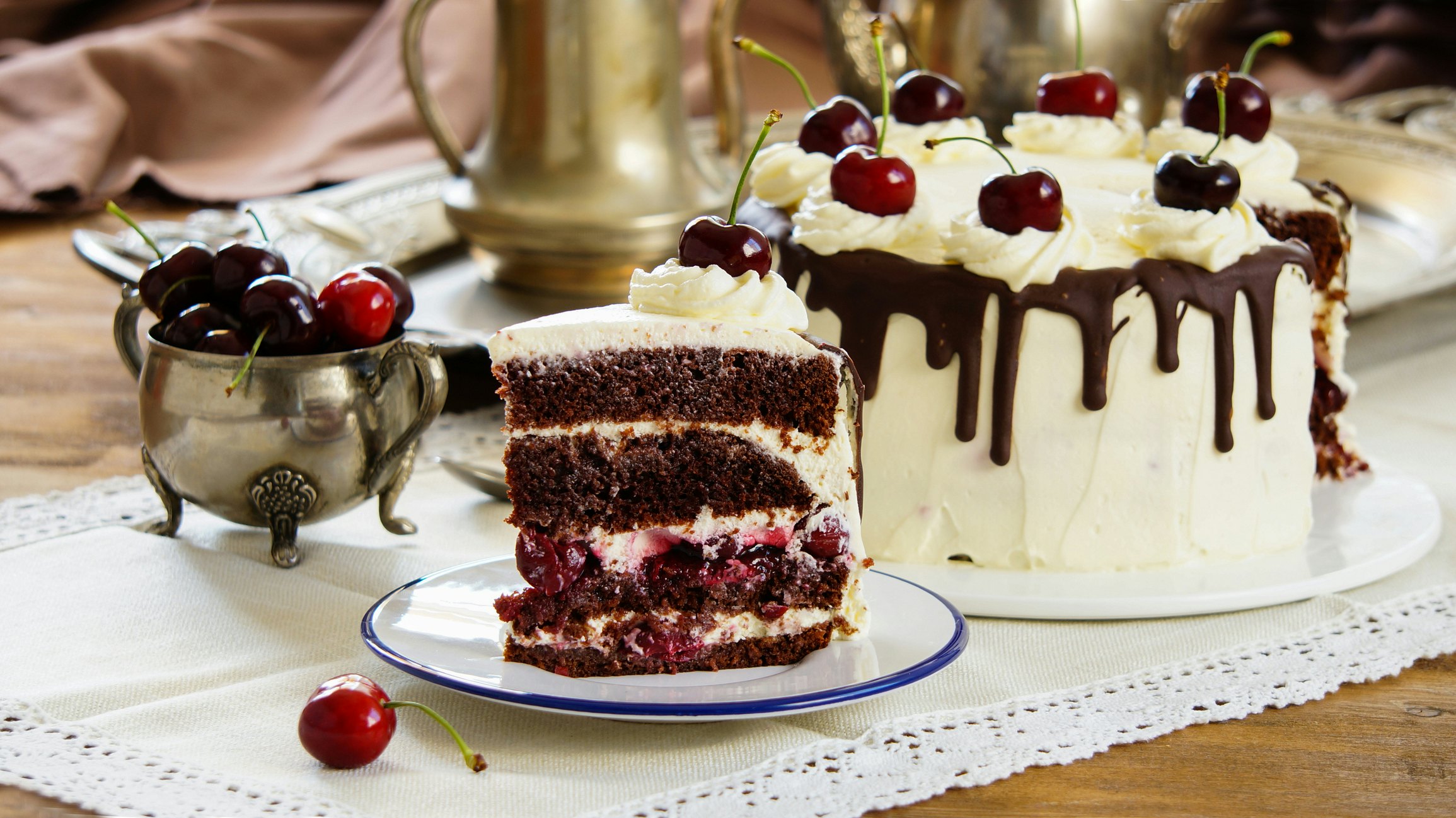
3. Schwarzwälder Kirschtorte in the Black Forest
Ask any local: the best Schwarzwälder Kirschtorte, or Black Forest cherry gateau, is the one their Mama (mother) or Oma (grandmother) makes – fresh from the oven, a great dumpy mess of cream and chocolate shavings, as unhealthy and delicious as you like. And that’s because those dodgy 1970s takes on this classic sweet got it all wrong – this cake doesn’t just need to look pretty, it needs to taste of a loving, generous home. Get it right and it’s a masterpiece: layers of light chocolate sponge perfumed with local Kirschwasser (cherry brandy), whipped cream and sour cherries all wrapped up in more cream and shaved chocolate. It’s a dessert to dive into.
Where to try it: You can eat Schwarzwälder Kirschtorte the world over, but it never tastes quite like the real deal found in the deep, dark Black Forest, which spreads a fir blanket across southwestern Germany. Rivals for the gateau crown are many, but you’d be hard pushed to find better than at old-school Café König in the ritzy spa town of Baden-Baden. Others rave about the one at Café Goldene Krone, a women’s cooperative cafe in the pretty village of St Märgen, topped off by a baroque pilgrimage church. For all-out indulgence, visit Todtnauberg in mid-April for the annual Black Forest Cake Festival.
Ready to plan your trip to Germany? Here's our guide to the top places to visit
4. Döner in Berlin
Almost every late-night party in Berlin winds up at a Döner Kebab (doner kebab) stand, where a hunk of juicy meat turns on a spit. And that’s all thanks to Kadir Nurman, the Turkish immigrant who had the brainwave to stuff a pitta pocket with spit-roasted lamb, salad and garlicky yogurt sauce back in 1972. The city has never looked back and the Döner still dominates German street food today. This fast food is also good for your budget. And if you don’t fancy the meaty version, many Imbiss (snack bar) serve vegetarian alternatives.
Where to try it: The longer the queue, the better the Döner, or so say Berliners. Well worth the wait is Mustafa's Gemüse Kebap next to Mehringdamm U-Bahn Station. Or for a more central pick, try Rosenthaler Grill and Schlemmerbuffet. Vöner in Friedrichshain wins the vegan Döner award for its spit-roasted blend of wheat protein, vegetables and herbs.

5. Fish feast in Northern Germany
Wash up on the bright, breezy, dune-buckled coast of the North Sea and Baltic in Northern Germany and you’re in for a fishy treat. For a briny burst of the sea, try dishes like Matjes (herring), Rollmops (pickled herring), Rotbarsch (like whiting), Nordseekrabben (tiny North Sea shrimps) and Hamburg’s much-loved Aalsuppe, sweet and sour eel and vegetable soup with spices and fruits like prunes, apples and pears. But the ultimate snack on the hoof has to be the Fischbrötchen (a roll stuffed with fish – usually herring – onions, pickles and creamy horseradish or cocktail sauce).
Where to try it: Hamburg is rammed with fish vendors, but standing head and shoulders above most is Brücke 10, where you can nosh on Matjes (brined herring) or a bulging shrimp sandwich. In List harbor, Gosch is a Sylt institution, with outstanding smoked fish and the Fischbrötchen of dreams.
6. Wurst all over Germany
When you start talking about Germany’s best wurst (sausages), things swiftly get personal and heated. They are from Bavaria. No, Frankfurt. Hang on, what about Thuringia? The smell of bratwurst sizzling on the grill, the sharp, sweet hit of Senf, the casual blob of kraut on the side – all yours for a fistful of change.
Grilled, boiled, baked and fried, served at an Imbiss or in a beer hall or garden, the humble sausage is among the best and most well-known German foods. It’s so sacred here that you’ll hear parents telling their children to eat every last bite, as if it were a vitamin-packed superfood. There’s the ubiquitous bratwurst, the Blutwurst (blood sausage), the Bockwurst (ground veal and pork with paprika, marjoram, chives and parsley), the Weisswurst (parboiled veal and bacon sausage flavored with parsley, mace and cardamom) and a million others besides.
Where to try it: Competition is hot, but Nuremberg’s Rotbratwurst (finger-sized pork sausages flavored with mace, pepper and marjoram) are arguably among Germany’s finest, especially when seared over a flaming beech-wood grill at the Bratwurstglöcklein. Munich claims its veal Weisswurst is better still. Take the lead of locals and gobble one for breakfast at the Viktualienmarkt. Thuringia’s pork-and-veal bratwurst stays true to a recipe dating from 1404. The ones sizzled over a smoky grill at Erfurt’s Faustfood are legend.
Don't miss Germany's best activities

7. Schwein meals in Bavaria
When many folk think of German food, they are actually thinking of Bavarian food – of the oompah-pah-fuelled, Lederhosen-clad feasts of Oktoberfest and dishes that have all the makings of a raucous medieval banquet. All of Germany likes a bit of pork, but the Bavarians are mad about it, eating every part of the pig. Cue the nose-to-tail beer hall classics: humongous schnitzels, pounded, breaded and fried to golden perfection, Schweinbraten (roast pork) with lashings of sauerkraut and tennis ball-sized Knödel (dumplings), Schweinshaxe (pork knuckle), Rippchen (ribs), Züngerl (tongue), Wammerl (belly) and Eisbein (salted ham hock).
Where to try it: Go for an all-out meat feast under the frescoed vaults of the Ratskeller deep in the basement of the city hall on Marienplatz in the heart of Munich.
8. Spätzle noodles in Swabia
In the Swabian region of Baden-Württemberg in Germany's southwest, locals are crazy about pasta-style dishes, which are heavier and eggier (leaning more towards dumplings) than what you’ll find in Italy, but tasty nonetheless. Top billing goes to Spätzle, stubby egg noodles, served as a side with Zwiebelrostbraten (roast beef with onions and gravy) or as a main as Käsespätzle, with loads of gooey cheese and fried onions. But keep an eye for Schupfnudeln, finger-sized potato dumplings.
Where to try it: Any good old-fashioned tavern will do, but among our favorites are the Gerberhaus, full of beamed, rustic warmth, in the canal-woven heart of Ulm.
9. Bring on the bier
"Hopfen und Malz – Gott erhalt's!" ("Hops and malt are in God's hands") goes the saying and indeed few things raise German passions like beer, where you’ll be told flat out – no arguments – that the country makes the world’s best. The logic is irrefutable: the beer here owes its "secret" to the 1516 Reinheitsgebot (purity law) passed in Bavaria, which stipulated that breweries use just four ingredients – malt, yeast, hops and water. Brewing here goes back to Germanic tribes, and later monks, so it follows a hallowed tradition. And indeed beer is brewed, consumed and celebrated here with a near-religious fervor, not least at the world's biggest beer festival and the ultimate must-visit, Oktoberfest.
Once you get into the nitty-gritty, you open up an entire world. Pils (Pilsner), a bottom-fermented pale lager, with a pronounced hop flavor and creamy head, and Helles (pale lager), slightly sweet and with strong malt aromas, are universally adored. But each region has its own treasures: Düsseldorf’s Altbier (dark, full beer with malted barley), Berlin’s cool, fruity, colorful Weisse, laced with raspberry or woodruff syrup, and Cologne’s hoppy, top-fermented Kölsch, served in small glasses (0.2L) called Stangen (literally "sticks").
Where to try it: Bavaria’s cloudy, amber-hued Weissbier (wheat beer) never tastes more refreshing than in a chestnut tree-shaded beer garden on a summer day (the Augustiner Keller is a good ‘un) or when swinging your tankard to oompah-pah at Oktoberfest. Dunkles (dark lager) is more full-bodied with strong malty aromas.
Keen to go to Oktoberfest? Here's our guide for first-time visitors
10. Handkäs mit Musik in Frankfurt am Main
Handkäs mit Musik (hand cheese with music) is a distinctive sour-milk cheese from Frankfurt, handmade and marinated in oil, vinegar and raw onions. The 'music' is typically thought to refer to the flatulence the onion marinade is known to cause, which adds a less-than-charming note to the dish. However, some believe the term originally referred to the melodic clinking of vinegar and oil containers as waiters carried them to the table. Traditionally served as an appetizer, Handkäs mit Musik is accompanied by bread and caraway, either sprinkled on top or served on the side. A classic pairing with the dish is apple cider, which complements its bold flavors.
Where to try it: The Old Sachsenhausen neighborhood in Frankfurt-Sud is where Handkäs mit Musik is found on the menus of traditional Apfelweingaststätte (or cider restaurants). Apfelwein Dax is a time-tested old-school pub establishment with a beer garden.
11. Himmel und Erde in Rheinland
Translated as “heaven and earth,” this comforting dish of mashed potato with stewed apples is a staple in many Rheinland homes. A common addition is blood sausage, because what's a German dish without a meaty accompaniment? Fried onions also often make an appearance, adding an extra layer of deliciousness to this hearty meal.
Where to try it: Head to Cologne to have Himmel un Äd (a local variation of the name) at Peters Brauhaus, a historic brewery that specializes in hearty Rheinland cooking.
12. Klaben in Bremen
This Stollen-like cake enjoys geographical protection from the EU, meaning that only local bakeries in Bremen can craft this sweet specialty. A beloved Christmas treat, Klaben is a type of sweet bread filled with raisins and other flavorful ingredients. The story of Klaben mirrors the history of Bremen itself, reflecting the city’s rich heritage. As trade flourished in the 16th century, local bakeries used ingredients from distant lands to create this exquisite fruit bread. In addition to raisins, Klaben includes almonds, orange and lemon peel, and a touch of rum. Looking for the perfect souvenir from Bremen? Klaben is an ideal choice, with its long shelf life making it a lasting food memory from Germany.
Where to try it: Café Knigge is a Klaben-serving bakery par excellence that has been baking Klaben since 1889. Mid-November is when the city organizes the traditional cutting of Klaben on the market square. Bremen's mayor cuts the first piece of the cake, which symbolizes the start of the holiday season.
13. Prinzregententorte in Munich
Cakes aren’t only for pleasure in Bavaria. They also represent political symbolism. Originally, Prinzregententorte had eight layers, with each representing a district in the Kingdom of Bavaria. Today, it has seven layers, as the district of Palatinate joined other lands. However, politics will likely be the last thing on your mind when savoring this decadent treat. Prinzregententorte is made up of thin, delicate layers of sponge cake, each separated by a rich, velvety chocolate buttercream. Some variations of the cake are topped with apricot jam, adding a subtle fruity note to balance the indulgent sweetness.
Where to try it: Although the origin of the cake is up for debate, Konditorei Erbshäuser says that it was here that the Prinzregententorte was created by Heinrich Georg Erbshäuser in 1886. The confectionery reopened in 2017 and serves some of the best layered cakes in Munich.
14. Schwäbische Maultaschen in Stuttgart
According to legend, Maultaschen is a dish that came out of sin. Cistercian monks of the Maulbronn Monastery (a stunning UNESCO-protected monastery complex in Baden-Württemberg) wanted to have meat during Lent. To “conceal” it from God, the inventive Cistercian cooks decided to mix minced meat with spinach and herbs. Sheets of pasta dough were added as an extra shield from their sinful acts. This explains the other name for the dish Herrgottsbescheißerle, meaning “God-cheaters.”
In any case, the dish became Southwestern Germany’s most beloved dumpling and got itself a European Union’s geographical protection status in 2009. Maultaschen pasta is usually large and served in two to four rectangular pieces. The classic recipe involves simmering them in broth (known as in der Brühe) or eating dumplings geschmälzt (with butter and onion topping).
Where to try it: Set in Stuttgart’s Red-light district (Leonhardsviertel), Weinstube Fröhlich is a surprisingly peaceful tavern with the best of Swabian food on the menu including Maultaschen.
15. Saumagen in Palatinate
Saumagen is a hearty dish made from seasoned potatoes and pork (spiced with marjoram and nutmeg) that are stuffed inside pig intestines. The dish is so influential in the region that the phrase "to have a Saumagen" is used to describe someone with a strong stomach. Former German Chancellor Helmut Kohl, who hailed from Palatinate, helped popularize Saumagen by serving it to distinguished guests like Margaret Thatcher, Mikhail Gorbachev and Václav Havel at official dinners.
Saumagen is Germany's answer to Scottish haggis and a twist on the wurst tradition. It is typically served fried, accompanied by mashed potatoes and sauerkraut. And you can’t go wrong pairing this meal with a Pfalz-produced glass of white wine.
Where to have it: Riverside Alten Hammer in the historic city of Speyer has been serving Saumagen since 1919. For sampling the dish in a traditional German atmosphere, visit Vetter's Alt Heidelberger Brauhaus in the UNESCO-protected Heidelberg.
Vegetarians and vegans might be surprised by the range of non-meat options
Germany was once a culinary wasteland for vegetarians and vegans – but no more. In cities up and down the country, you’ll find cafes and restaurants with chefs riffing creatively on shoots and roots and where veggies take center stage. Even Imbiss serves non-meat treats – from falafel to veggie sausages and kebabs. In rural areas, things can be more challenging, but you’ll always find a couple of vegetarian options on menus – potato- and pasta-based dishes are good bets.
In Berlin, gourmet vegetarian and vegan restaurants are popping up quicker than mushrooms after a rainstorm, with the likes of cool Schöneberg bistro Bonvivant, pairing cocktails with season-spun vegetables. Organic kohlrabi with pine, elder and black apple? Bring it on. In the Scheunenviertel, climate-neutral Kopps treats vegans to plant-based fine dining, teasing extraordinary flavors out of vegetables in wonders like chestnut with currant wood and truffle. While over at Checkpoint Charlie, Berlin-born wunderkind Tim Raue brings a pinch of Asian spice to the equation in vegan tasting menus.
Never one to miss a culinary trick, Munich has Prinz Myshkin, dishing up imaginative vegan and vegetarian cuisine in a slickly revamped, minimalist-chic vaulted space.
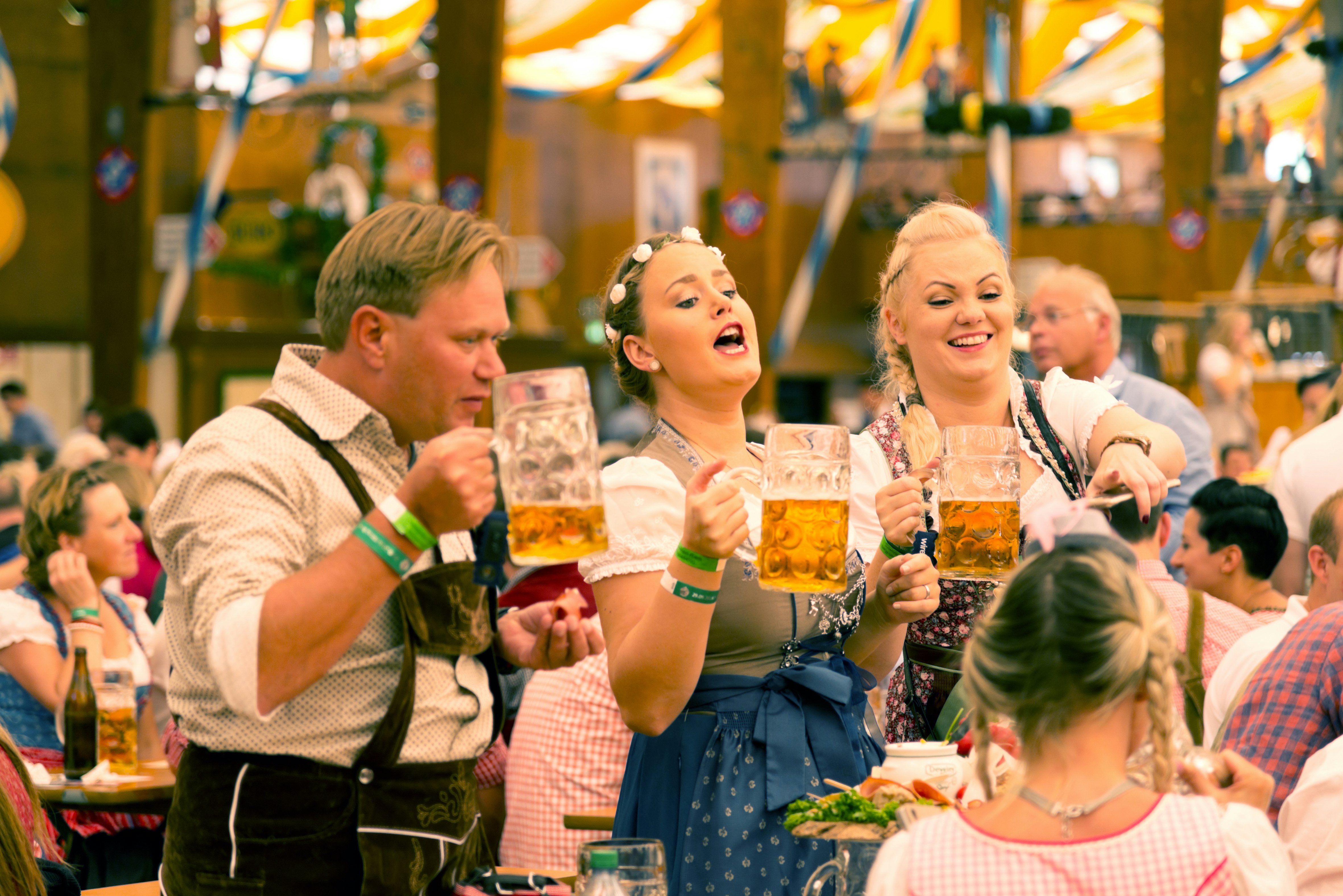
A year in food
March to May
Germans go nuts for asparagus during Spargelzeit (asparagus season). Bärlauch (wild garlic) is bountiful and Baltic towns celebrate the humble herring.
June to August
Pfifferlinge (chanterelle mushrooms) and a feast of forest berries trumpet summer’s arrival. Beer gardens brim with people lapping up the warm weather, and folksy wine festivals are in full swing.
September to October
Autumn days are rich and earthy, with game, wild mushrooms and pumpkins aplenty. At Oktoberfest in September, 5.7 million partygoers wash down entire farms of pigs, oxen and chickens with Mass (liters) of beer.
December
’Tis the season for gingerbread, stollen and Glühwein (mulled wine) at Christmas.








